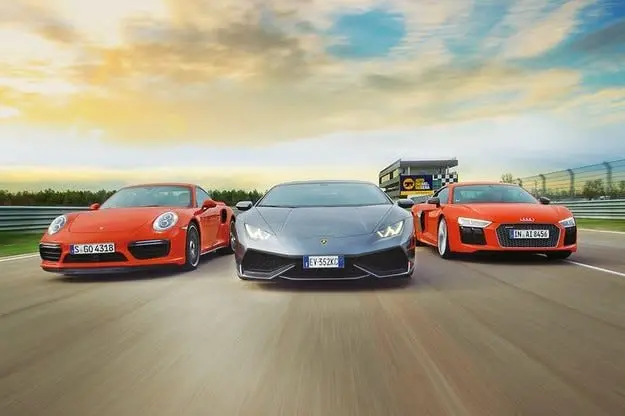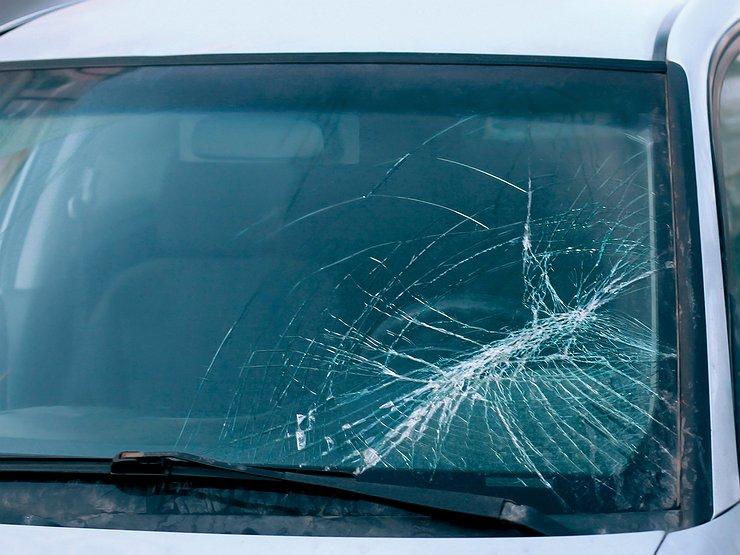
Test drive battle of sports giants
Content

Lamborghini Hurricane LP 610-4 against Audi R8 V10 Plus and Porsche 911 Turbo S
Quote from a letter from the reviewed reader 3/2016 of sport auto magazine: It's really great when one of the cars tested has a great time cruising around the track. But given the fact that the average reader is likely to drive 95 percent of their personal mileage on public roads, disadvantages such as too wide a body and poor visibility should be criticized as eloquently as being overweight. ” End of quote. Dear Carlo Wagner, thank you very much! Because not only the apocalyptic weather on the day of filming in Hockenheim, but also your lines prompted us to take a dream walk.
Today, the Porsche 911 Turbo S and Audi R8 V10 Plus will accompany the Lamborghini Huracán LP 610-4 from Hockenheim to "home", i.e. Sant'Agata Bolognese in Italy. After passing 800 kilometers of roads and highways, we should not only get good weather, but also accumulate a rich experience of driving sports cars in everyday life. And now, with our Lamborghini, along with truck hubs, crammed into the rush of the highway being repaired and heading south, I am reluctant to reflect on the positions of perhaps the most active reader. I admit that a good review has nothing to do with the situation around me. In retrospect, it can be compared to a slit in the armor of a medieval knight - but wouldn't that deny the Italians the protruding uniforms and the famous Miura curtains on the back?
Lamborghini Huracán - ready for the museum?
It's all part of the Lamborghini madness - just like high-speed emotion from a naturally aspirated engine. Pull the fixed plate to the left towards the steering column and downshift. Full throttle - and the atmospheric ten-cylinder engine accelerates its 610 horsepower, greedily takes gas, picks up speed and this intoxicating party continues to a maximum of 8700 rpm.
In fact, we should take this Huracán straight to the company's museum as unique. Because until now, the cars of the Italian manufacturer have always faced difficulties when they had to prove their factory characteristics. However, our Huracán, with a result of “two and nine”, falls three tenths below the promised acceleration from zero to a hundred, and to 200 km / h even six tenths faster than declared - and, mind you, with a full 80-liter tank and a measuring crew of two Human.
Audi R8 V10 Plus compared to Huracán for the first time
Roadside complex Intal, right in front of the border with Austria. We buy vignettes, we feed a gang of sports cars with high-octane gasoline, we change cars. 911 Turbo S or R8? A delightfully difficult choice. We get to R8. Aside from the V10 engine drivetrain and seven-speed dual-clutch transmission, the current R8 and Huracán share many similarities, such as hybrid aluminum and composite construction, and a heavily developed chassis (MSS - Modular Sportscar System).
To my surprise, the two mid-engined cars feel completely different when driving on the public road network. On the one hand, Huracan is an avid purist; on the other hand, the R8 is a racing athlete with a center bike and palpable ride comfort. The Lamborghini Huracán LP610-4 carbon fiber seat, available at an additional cost, with strong lateral support, allows you to turn any corner of the motorway into a Parabolica. However, much before the 400-kilometer non-stop track is over, the places where the pressure on the semi-lined hard Alcantara seat starts to hurt. But to be honest, for Huracán I would put up with even bruises.
Audi exploits the Lambo's lack of comfort
In the Italian hero with a central motorcycle, the veil of comfort never obscures the driving experience. The V10 music behind the driver's back penetrates his ears in such an unfiltered form, as if he was sitting not in the box of the opera, but in the center of the orchestra. For this show, you're willing to forgive him for being with the optional Trofeo R tires for everyday asphalt driving, or for the lack of rear visibility without the optional Park Distance Control, making it as easy to maneuver as the Leopard 2.
What about R8? Two clicks on the steering wheel pivot and the Audi R8 V10 Plus will make every track feel like a real Unode at Le Mans. Audi takes advantage of the Lambo's lack of comfort and immediately outscores it in everyday driving with stress-free seating. Despite the well-known values of the Huracán sprint, Audi fans have no reason to worry either. Even before the trip to the south, the R8 showed excellent shape in our test rights. In 3,0 seconds from zero to hundreds, the model also improves the value of the factory data - by two tenths of a second. When the R8 finds a free stretch of highway, it even overtakes its Italian cousin. At 330 vs 225 km/h, the top speed cup goes not to Sant'Agata, but to Neckarsulm.
Porsche 911 Turbo S and restrained brutality
Or in Zuffenhausen. The second-generation Turbo S of the 991 increases top speed from 318 to 330 km/h. It's true that the Turbo S doesn't take the bait of gas like its naturally aspirated rivals the R8 and Huracán, but the feeling when a Porsche is at 250 km/h h moves down one step and with a seemingly endlessly unstoppable thrust, makes the face of your inexperienced comrade turn white as chalk - yes, this sensation is simply sensational.
The top-of-the-line Porsche 911 Turbo S immediately seals the best performance on the pavement. And in the second generation, you would have looked in vain for classic turbo tunes like compressor tweets. Today, only the R8 and Huracán are fighting for the title in the sound rating. Thanks to changes such as new larger turbochargers, higher pressure and a redesigned injection system, modified intake manifolds and a modified air intake system, the six-cylinder unit now has 580 hp. that is, with 20 hp. more than the first generation 991 Turbo S. As with its direct predecessor, the perfectionist Launch Control system also provides the best acceleration values on the conveyor belt. Today we are again surprised not so much by the 2,9 / 9,9 seconds values for the sprints at 100 and 200 km / h, but by their multiple reproducibility.
No stress and express speed in Turbo S
But even at high speeds, a Porsche can offer a sense of calm well-being. Some critics find this super-reminiscent comfort rather boring, but the acoustical restraint compared to the R8 and Huracán makes going a thousand kilometers into something effortlessly possible. And add: I am pleased that after driving on the highway, the drama of a sports car continues to ring in your ears like a scream after attending a disco.
It may sound incredible, but the new Turbo "smoothes" waves on the pavement even more comfortably than its direct predecessor. For this, the electronically controlled PASM dampers have been given an even more sensitive setting for normal mode. In addition, the Turbo S is incomparably quieter than the Huracán and Audi R8 V10 Plus in terms of straight-line stability.
Highway, highway, racetrack
Brenner, Bolzano, Modena - Italy, here we go! We drove quite calmly along the highway, the passionate roads of Emilia-Romagna are waiting for us, like a labyrinth of turns Via Romea Nonantolana occidentale. All three sports models are in their element here. While the perfectionist Turbo S cuts corners with all-wheel drive but never forgets its mission of comfort, here the Huracán is more like a racing car. R8 is somewhere in the middle.
The standard Static Plus chassis of the test R8 always gives reliable feedback on the road, but even without the optional and more comfortably tuned Magnetic Ride chassis of an Audi car, it doesn't overload your vertebrae. Although the Huracán is equipped with the optional Magneride suspension with electromagnetic damping, in all situations of life it feels significantly more rigid than the static chassis of Audi.
Audi R8 V10 Plus with a wide range of modes
The programs of the Drive Select system in the R8 (Comfort, Auto, Dynamic, Individual modes) affect not only the characteristics of the accelerator pedal, dual clutch transmission, dual transmission and exhaust system, but also the characteristics of the desire for "dynamic management". The electromechanical steering system offers settings for every taste, from comfortable to high steering effort, as well as adjustable steering gear ratios.
The Huracán being tested is not equipped with the optional LDS (Lamborghini Dynamic Steering) steering system and has a standard electromechanical steering with a fixed gear ratio (16,2: 1). Overall, the Lambo's steering works precisely in mid-wheel position, and because it requires more effort and provides uneven feedback, it feels rougher but somewhat more authentic than the R8's steering.
Goodbye Porsche Management
And what about the Turbo steering? Compared to the first generation 991, its features have been tuned for even greater comfort. This is good on the highway and in the city, but on a road with many bends, you gradually start to miss the tough Porsche character from the past 911 days. The required steering angle has increased significantly again. Run 997 to compare and you will find out what is lost here!
The fact that the 991.2's steering in the Turbo S has lost some of its straightness around the mid-wheel position not only feels like a hairpin in tight corners on secondary roads, but also on the race track. Whereas the first generation R8 used to be a car that tied its hands in a knot in tighter corners, the Turbo S now requires the greatest cornering angle of today's trio's rivals.
Porsche 911 Turbo S is as fast as GT3 RS
Blue and yellow borders instead of blue and white. At the Autodromo di Modena we run fast laps for a photo session and as always we saw the time on the short circuit in Hockenheim. 1.08,5 minutes – in the GT Porsche department, the lap time from Hockenheim is sure to spark heated discussions and at the same time bring a new dose of motivation. The current Turbo S is not only two-tenths of a second faster than its direct predecessor, it's also accurate. as fast as the track hero 991 GT3 RS with Michelin Pilot Sport Cup 2 tires. The number two 991 Turbo S no longer competes as the number one 991 Turbo S with the optional Dunlop Sport Maxx Race, but with the new generation Pirelli P Zero with the name "N1" (so far "N0").
Traction levels in the Dunlop semi-similar tires generally looked better than in the new Pirelli that the Turbo S is equipped with from the factory. Especially when braking, a slightly lower level of traction could be felt and measured. With a top speed of 11,7 m/s – 2, the 991.2 Turbo S does not quite reach the deceleration values of the 991.1 Turbo S with Dunlop Sport Maxx Race tires (max. 12,6 m/s – 2). On standard stopping distance measurement, the powerful 911 stopped at 100 km/h in 33,0 m (previously with the Dunlop Sport Maxx Race 1 at 31,9 m).
PDK with shift strategy from GT models
All these are complaints and grievances in search of the best of the best. Through the interplay of variable dual transmission, electronically controlled rear axle lock (PTV Plus), rear axle control and PDCC tilt compensation, the latest Turbo S approaches the traction limit with virtuosic safety and extremely easy-to-control behavior. on the road. Side roll, understeer when turning the steering wheel, strange movements when releasing the throttle - all of these are unusual concepts for the Turbo S in borderline situations.
By precisely entering the corner, you can step on the accelerator early and the Porsche hero, armed with a dual transmission, conquers the corner with impressive grip. At the same time, the Turbo S exhibits amazing cornering speed – although, unlike the R8 and Huracán, it is not shod with a half-open image. The performance of the ABS system is typical of Porsche and is at a very high level. Like the Carrera, Turbo models now use the PDK gearbox with the shift strategy from the GT versions. In addition, manual mode is now truly manual. The new Turbo S no longer shifts to a higher speed when reaching top speed - another reason to give it a thumbs up!
Audi R8 V10 Plus is even faster than the previous test
And does the R8 V10 Plus Turbo S meet the traction limit? At 1658 kilograms, the Audi is the heaviest of the trio – you can feel it in comparison. But the reduced need to turn the steering wheel at a large angle immediately makes a positive impression on the track. In addition, they managed to minimize the pronounced understeer. However, there is slight understeer when turning the steering wheel, which is noticeable by tire wear on the front axle after a few laps.
After two or three laps at Hockenheim, the Michelin Cup's grip is already starting to decline and understeer is increasing again. Compared to the R8 from the previous test, the current test car is subjectively slightly more responsive to acceleration. If you go too digital with your driving style and deactivate the ESP system, then with its sharp characteristics when the dynamic load changes, the R8 will require you to react with the same sharp steering wheel responses.
By selecting the so-called “performance mode” (Snow, Wet or Dry modes – for snow, wet and dry track) the central engine sports car can be tamed. In the "Dry" position, the R8 works with the sporty settings of the ESC and continues to use, albeit sparingly, the regulating action of the ESC. Acceleration response is reduced, and the rear of the Audi only slightly works under load and provides good traction. At 1.09,0 minutes, the R8 V10 Plus delivers 4 tenths of the lap time of the previous test.
Lamborghini Huracán LP 610-4 outperforms the competition
And how does Huracan behave compared to his close relative? Quickly sharpen the Lambo's senses by disengaging ESC, then flip the steering wheel dynamics switch from Strada to Corsa. The engine, transmission and dual transmission system are now tuned for maximum lateral dynamics. From the first meters of the track we notice that the Italian is almost 100 kilograms lighter than the R8. Despite roughly the same weight distribution, the Huracán moves more dynamically, but at the same time more stable than the R8, when driving at the traction limit. Precise cornering and acceleration with excellent traction - the Lamborghini behaves significantly more neutrally than the R8 throughout the entire corner. There are no acute withdrawal reactions.
This is also facilitated by the even better flotation of the Trofeo R additional tires compared to the Michelin Cup kit. Lambo cannot come close only to the successful ABS settings on the R8. When the brake pedal is in full swing, the Huracán impresses with its inharmonious ABS response.
And yet the Italian manages to completely surprise us. With a lap time of 1.07,5 minutes, it more than eloquently surpassed both of its current competitors. So the Lamborghini Huracán really deserves to be sent to Sant'Agata in a Porsche 911 Turbo S and Audi R8 V10 Plus.
CONCLUSION
What a wonderful tribe! If you are looking for a versatile vehicle for everyday use and for the tracks, then the 911 second generation Porsche 991 Turbo S is your ideal partner. But for all its perfection, the Porsche is definitely not the most emotional car in the comparison test. The Audi R8 V10 Plus and its platform sibling, the Lamborghini Huracán LP 610-4, highlight the hairs on the back of the head thanks to the fantastic concert of their high-revving naturally-aspirated V10 engines. In turn, the two center-engined athletes must show leniency in other areas. Lamborghini demonstrates excellent sporting qualities, but in everyday life it requires a willingness to compromise (for example, in terms of visibility and due to the practically insufficient grip of Trofeo tires on the wet road!). The Audi R8 handles the sword better in day-to-day life, but is forced to give way on the track instead.
Text: Christian Gebhart
Photo: Hans-Dieter Zeifert
technical details
| 1. Lamborghini Huracan LP 610-4 | 2. Porsche 911 Turbo S. | 3.Audi R8 V10 Plus | |
|---|---|---|---|
| Working volume | 5204 cc | 3800 cc | 5204 cc |
| Power | 610 k.s. (449 kW) at 8250 rpm | 580 k.s. (427 kW) at 6500 rpm | 610 k.s. (449 kW) at 8250 rpm |
| Maximum torque | 560 Nm at 6500 rpm | 750 Nm at 2200 rpm | 560 Nm at 6500 rpm |
| Acceleration 0-100 km / h | 3,2 with | 2,9 with | 3,2 with |
| Braking distances at a speed of 100 km / h | 32,9 m | 33,0 m | 33,2 m |
| full speed | 325 km / h | 330 km / h | 330 km / h |
| Average consumption fuel in the test | 16,6 l / 100 km | 14,5 l / 100 km | 15,9 l / 100 km |
| Base Price | 201 705 EUR (in Germany) | 202 872 EUR (in Germany) | 190 000 EUR (in Germany) |

